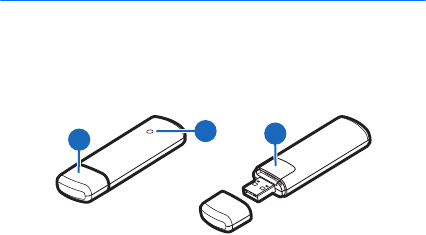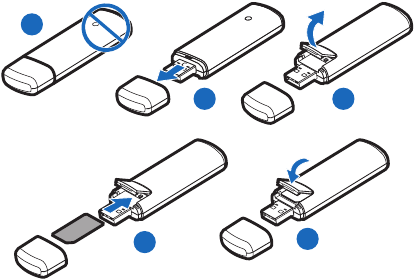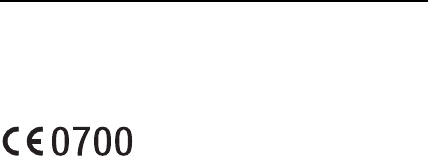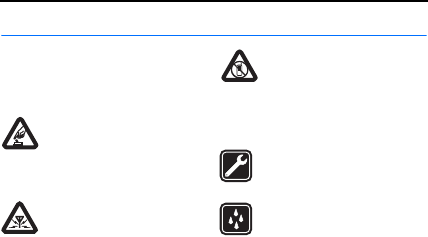Microsoft RD-15 GSM/WCDMA Internet modem User Manual CS 11 QSG en US1 Update1
Microsoft Mobile Oy GSM/WCDMA Internet modem CS 11 QSG en US1 Update1
Manual

Nokia Internet Stick CS-11
9221181/1
3
1
2

4
56
78

ENGLISH
DECLARATION OF CONFORMITY
Hereby, NOKIA CORPORATION declares that
this RD-15 product is in compliance with the
essential requirements and other relevant
provisions of Directive 1999/5/EC. A copy of
the Declaration of Conformity can be found
at http://www.nokia.com/phones/
declaration_of_conformity/.
© 2010 Nokia. All rights reserved.
Nokia, Nokia Connecting People and the
Nokia Original Accessories logo are
trademarks or registered trademarks of
Nokia Corporation. Other product and
company names mentioned herein may be
trademarks or tradenames of their respective
owners.
Reproduction, transfer, distribution, or
storage of part or all of the contents in this
document in any form without the prior
written permission of Nokia is prohibited.
Nokia operates a policy of continuous
development. Nokia reserves the right to
make changes and improvements to any of
the products described in this document
without prior notice.
To the maximum extent permitted by
applicable law, under no circumstances shall
Nokia or any of its licensors be responsible
for any loss of data or income or any special,
incidental, consequential or indirect
damages howsoever caused.
The contents of this document are provided
"as is". Except as required by applicable law,
no warranties of any kind, either express or
implied, including, but not limited to, the
implied warranties of merchantability and
fitness for a particular purpose, are made in
relation to the accuracy, reliability or
contents of this document. Nokia reserves
the right to revise this document or
withdraw it at any time without prior notice.
The availability of particular products and
applications and services for these products
may vary by region. Please check with your
Nokia dealer for details, and availability of
language options. This device may contain
commodities, technology or software
subject to export laws and regulations from
the US and other countries. Diversion
contrary to law is prohibited.

ENGLISH
SAFETY
Read these simple guidelines. Not
following them may be dangerous or
illegal. Read the complete user guide for
further information.
SWITCH ON SAFELY
Do not switch the device on
when wireless phone use is
prohibited or when it may cause
interference or danger.
INTERFERENCE
All wireless devices may be
susceptible to interference,
which could affect performance.
SWITCH OFF IN RESTRICTED
AREAS
Follow any restrictions. Switch
the device off in aircraft, near medical
equipment, fuel, chemicals, or blasting
areas.
QUALIFIED SERVICE
Only qualified personnel may
repair this product.
WATER-RESISTANCE
Your device is not water-
resistant. Keep it dry.
■About your device
The wireless device described in this
guide is approved for use on the (E)GSM
850, 900, 1800, and 1900, and UMTS
850/1900/2100 HSPA networks. Contact
your service provider for more
information about networks.
During extended operation, such as a
high speed data connection, the device
may feel warm. In most cases, this

ENGLISH
condition is normal. If you suspect the
device is not working properly, take it to
the nearest authorized service facility.
When connecting to any other device,
read its user guide for detailed safety
instructions. Do not connect
incompatible products.
■Network services
To use the device you must have service
from a wireless service provider. Some
features are not available on all
networks; other features may require
that you make specific arrangements
with your service provider to use them.
Network services involve transmission of
data. Check with your service provider for
details about fees in your home network
and when roaming in other networks.
Your service provider can explain what
charges will apply. Some networks may
have limitations that affect how you can
use some features of this device requiring
network support.
Introduction
The Nokia Internet Stick CS-11 is a
wireless modem that lets you transfer
data in cellular networks.
To use the device with your computer,
you need the Nokia Internet Modem
application that is automatically
installed when you connect the device
to the computer for the first time.
Read this guide carefully before using
the device. Also read the user guides
for the Nokia Internet Modem
application, your computer, operating

ENGLISH
system, and any software that you use
with the internet connection set up
through the device.
For additional information, go to
www.nokia.com/support or your local
Nokia website.
Warning: The plug of this
device may contain a small
amount of nickel. Persons
who are sensitized to nickel may have
symptoms from prolonged skin
contact with the plug.
Read the user guide for Nokia
Internet Modem
To read the user guide for the Nokia
Internet Modem application, you must
have a PDF reader application
installed on your computer. You can
download the PDF reader, for example,
from the Adobe website.
To access the user guide, select the
question mark (Help) in the main view
of the Nokia Internet Modem
application. The user guide is
displayed in the language that you
selected during the installation of the
application.
Supported hardware and
software
The USB plug on the device supports
the data transfer rates defined in the
USB specification version 2.0.
To use the device for data transfer
with your computer, the computer
must have a 500 MHz 32-bit (x86) or
64-bit (x64) processor or faster, a
compatible USB port, and 350
megabytes of available space on the
hard disk. You also need one of the
following operating systems:
Microsoft Windows XP (Service Pack 2
with Hotfix KB943198, or Service Pack
3 or newer), Microsoft Windows Vista,
Windows 7, Linux Ubuntu 9.04, or
Apple Mac OS 10.4, 10.5, or 10.6.

ENGLISH
Microsoft Windows XP 64-bit Edition
is not supported.
Get started
The device contains the following
parts shown on the title page:
indicator light (1), USB plug covered
with a protection cap (2), and cover of
the SIM card slot (3).
Antenna locations
Your device has internal antennas. Avoid
touching the antenna area (4)
unnecessarily while the antenna is
transmitting or receiving. Contact with
antennas affects the communication
quality and may cause a higher power
level during operation and may reduce
the computer battery life.
Insert the SIM card
Warning: Keep the
protection cap out of the
reach of small children.
1. Remove the protection cap (5).
2. Lift the cover of the SIM card slot
(6).
3. Insert the SIM card (7).
Ensure that the contact surface on
the card is facing down, and the
beveled corner is on the right.
4. To close the cover, press it against
the device (8), and slide it into
place.
First time setup
To set up the device for your computer,
you may need the administrator rights
for the operating system. You may
also need to change the firewall
settings of your operating system to
let the device access the internet.

ENGLISH
1. Ensure that a SIM card is inserted
in the device.
2. Remove the protection cap from
the USB plug.
3. Switch on your computer, and
connect the device to the USB port
on the computer, so that the Nokia
logo is facing up.
Tip: To connect the device
to a compatible computer
using the Nokia
Connectivity Cable CA-175D,
connect the cable to the USB plug
and the USB port on the computer.
4. To install the device and the Nokia
Internet Modem application, do
one of the following:
• In Windows, the installer opens
automatically if the autorun
feature is enabled.
• In Mac OS, double-click the
Nokia Internet Stick CS-11
setup icon and then the Nokia
Internet Modem icon.
• In Linux, double-click the CD
drive and then the
nokiaInternetmodem.deb icon.
Select Install Package.
5. Select the desired language from
the list, and select OK. Follow the
displayed instructions.
Carefully read the end-user license
agreement and accept it.
The application and the needed
drivers are installed on your
computer. The installation may
take several minutes.
6. Based on your SIM card, the device
automatically tries to define the
settings for the cellular network of
your service provider (operator).
7. When prompted, enter the
personal identification number
(PIN) code of your SIM card. The
PIN code helps to protect your SIM

ENGLISH
card against unauthorized use and
is usually supplied with the card.
The main view of the Nokia Internet
Modem application is displayed.
8. To exit the Nokia Internet Modem
application, select X.
9. To disconnect the device from the
computer, unplug the device from
the USB port.
You may need to stop the device
before disconnecting it, if your
operating system supports this
function.
Indicator light
If the indicator light is red, the device
cannot register to a cellular network
because the SIM card is not valid or
properly inserted or cannot find a
supported network in your location. If
the red light flashes, the device is not
registered to a cellular network
because you have not entered the PIN
code, if the PIN code request is
enabled in the Nokia Internet Modem
application.
If the indicator light is green, the
device is registered to a GSM network
and transferring data. If the green
light flashes, the device is registered
to a GSM network, but the data
connection is not active.
If the indicator light is blue, the device
is registered to a 3G network and
transferring data. If the blue light
flashes, the device is registered to a
3G network, but the data connection
is not active.
Uninstall
To uninstall the device and the Nokia
Internet Modem application from your
computer, do one of the following:
• In Windows, select the uninstall
application from the Start menu.

ENGLISH
• In Mac OS, select the uninstall icon
in the Nokia folder.
• In Linux, use the package manager.
Connect to the internet
For the availability of data services,
pricing, and tariffs, contact your
service provider.
1. When a SIM card is inserted in the
device, switch on the computer,
and connect the device to the
computer.
2. If the Nokia Internet Modem
application does not start
automatically, do one of the
following:
• In Windows, start the
application from the Start
menu. For example, in Windows
XP, select Start > Programs >
Nokia > Nokia Internet Modem
> Nokia Internet Modem.
• In Mac OS, select the
application from the Finder.
• In Linux, select Applications >
Internet > Nokia Internet
Modem.
3. If prompted, enter the PIN code of
your SIM card.
4. Check the network indicator light
to see whether a network
connection is available.
5. To connect to the internet, select
Internet Connection > . Start
using the connection with the
software you want.
During data transfer, the Internet
Connection window shows the
transmission rate of sent (Rate out)
and received (Rate in) data, the

ENGLISH
duration of the current session,
and the total amount of data sent
and received during the session
(Volume).
If the computer enters standby or
hibernation mode, data transfer
may stop. Using the device for data
transfer increases the demand on
computer battery power and
reduces the battery life.
6. To close the connection, in the
Internet Connection window,
select .
To exit the application, select X.
This also closes the connection.
To minimize the application without
closing the active connection, select
. To restore the application
window, select the icon of the
minimized application.
Taking care of your device
Your device is a product of superior
design and craftsmanship and should be
treated with care. The following
suggestions will help you protect your
warranty coverage.
• Keep the device dry. Precipitation,
humidity, and all types of liquids or
moisture can contain minerals that
will corrode electronic circuits. If your
device does get wet, allow it to dry
completely.
• Do not use or store the device in
dusty, dirty areas. Its moving parts
and electronic components can be
damaged.
• Do not store the device in high or cold
temperature. High temperatures can
shorten the life of electronic devices,
damage batteries, and warp or melt
certain plastics. When the device
warms to its normal temperature
from a cold temperature, moisture

ENGLISH
can form inside the device and
damage electronic circuit boards.
• Do not attempt to open the device
other than as instructed in this guide.
• Do not drop, knock, or shake the
device. Rough handling can break
internal circuit boards and fine
mechanics.
• Do not use harsh chemicals, cleaning
solvents, or strong detergents to
clean the device. Only use a soft,
clean, dry cloth to clean the surface of
the device.
• Do not paint the device. Paint can
clog the moving parts and prevent
proper operation.
These suggestions apply equally to your
device or any accessory.
Recycle
Always return your used electronic
products, batteries, and packaging
materials to dedicated collection points.
This way you help prevent uncontrolled
waste disposal and promote the recycling
of materials. Check product
environmental information and how to
recycle your Nokia products at
www.nokia.com/werecycle, or
nokia.mobi/werecycle.
The crossed-out wheeled-bin
symbol on your product,
battery, literature, or packaging
reminds you that all electrical
and electronic products,
batteries, and accumulators must be
taken to separate collection at the end of
their working life. This requirement
applies in the European Union. Do not
dispose of these products as unsorted
municipal waste. For more environmental
information, see the product Eco-
Declarations at www.nokia.com/
environment.

ENGLISH
Additional safety information
■Small children
Your device and its accessories are not
toys. They may contain small parts. Keep
them out of the reach of small children.
■Operating
environment
This device model has been tested and
meets RF exposure guidelines when
positioned at least 0.5 centimetres (1/5
inches) away from the body when
plugged directly into a USB port on the
host device or used at the end of the
Nokia Connectivity Cable CA-175D that
may be supplied in the sales package.
■Medical devices
Operation of any radio transmitting
equipment, including wireless phones,
may interfere with the function of
inadequately protected medical devices.
Consult a physician or the manufacturer
of the medical device to determine
whether they are adequately shielded
from external RF energy. Switch off your
device when regulations posted instruct
you to do so. Hospitals or health care
facilities may use equipment sensitive to
external RF energy.
Implanted medical devices
Manufacturers of medical devices
recommend a minimum separation of
15.3 centimeters (6 inches) between a
wireless device and an implanted medical
device, such as a pacemaker or implanted
cardioverter defibrillator, to avoid
potential interference with the medical
device. Persons who have such devices
should:

ENGLISH
• Always keep the wireless device more
than 15.3 centimeters (6 inches) from
the medical device.
• Turn the wireless device off if there is
any reason to suspect that
interference is taking place.
• Follow the manufacturer directions
for the implanted medical device.
If you have any questions about using
your wireless device with an implanted
medical device, consult your health care
provider.
Hearing aids
Some digital wireless devices may
interfere with some hearing aids.
■Vehicles
RF signals may affect improperly
installed or inadequately shielded
electronic systems in motor vehicles such
as electronic fuel injection, electronic
antilock braking, electronic speed
control, and air bag systems. For more
information, check with the
manufacturer of your vehicle or its
equipment.
Only qualified personnel should service
the device. Faulty service may be
dangerous and may invalidate your
warranty. Do not store or carry
flammable liquids, gases, or explosive
materials in the same compartment as
the device, its parts, or accessories.
Switch off your device before boarding
an aircraft. The use of wireless
teledevices in an aircraft may be
dangerous to the operation of the
aircraft and may be illegal.
■Potentially explosive
environments
Switch off your device in any area with a
potentially explosive atmosphere. Obey
all posted instructions. Sparks in such
areas could cause an explosion or fire
resulting in bodily injury or death. Switch

ENGLISH
off the device at refuelling points such as
near gas pumps at service stations.
Observe restrictions in fuel depots,
storage, and distribution areas; chemical
plants; or where blasting operations are
in progress. Areas with a potentially
explosive atmosphere are often, but not
always, clearly marked. They include
areas where you would be advised to turn
off your vehicle engine, below deck on
boats, chemical transfer or storage
facilities and where the air contains
chemicals or particles such as grain, dust,
or metal powders. You should check with
the manufacturers of vehicles using
liquefied petroleum gas (such as propane
or butane) to determine if this device can
be safely used in their vicinity.
■Certification
information (SAR)
This mobile device meets guidelines for
exposure to radio waves.
Your mobile device is a radio transmitter
and receiver. It is designed not to exceed
the limits for exposure to radio waves
recommended by international
guidelines. These guidelines were
developed by the independent scientific
organization ICNIRP and include safety
margins designed to assure the
protection of all persons, regardless of
age and health.
The exposure guidelines for mobile
devices employ a unit of measurement
known as the Specific Absorption Rate or
SAR. The SAR limit stated in the ICNIRP
guidelines is 2.0 watts/kilogram (W/kg)
averaged over 10 grams of tissue. Tests
for SAR are conducted using standard
operating positions with the device
transmitting at its highest certified
power level in all tested frequency bands.
The actual SAR level of an operating
device can be below the maximum value
because the device is designed to use
only the power required to reach the
network. That amount changes

ENGLISH
depending on a number of factors such
as how close you are to a network base
station.
SAR values may vary depending on
national reporting and testing
requirements and the network band.
Additional SAR information may be
provided under product information at
www.nokia.com.
This device model has been tested and
meets RF exposure guidelines when
positioned at least 0.5 centimetres (1/5
inches) away from the body when
plugged directly into a USB port on the
host device or used at the end of the
Nokia Connectivity Cable CA-175D that
may be supplied in the sales package.
Your device is also designed to meet the
requirements for exposure to radio waves
established by the Federal
Communications Commission (USA) and
Industry Canada. These requirements set
a SAR limit of 1.6 W/kg averaged over
one gram of tissue. The highest SAR value
reported under this standard during
product certification when positioned 0.5
cm (1/5 inches) away from the body is
0.81 W/kg.
FCC/Industry Canada notice
Your device may cause TV or radio
interference (for example, when using a
telephone in close proximity to receiving
equipment). The FCC or Industry Canada can
require you to stop using your telephone if
such interference cannot be eliminated. If
you require assistance, contact your local
service facility. This device complies with
part 15 of the FCC rules. Operation is subject
to the following two conditions: (1) This
device may not cause harmful interference,
and (2) this device must accept any
interference received, including interference
that may cause undesired operation. Any
changes or modifications not expressly

ENGLISH
approved by Nokia could void the user's
authority to operate this equipment.